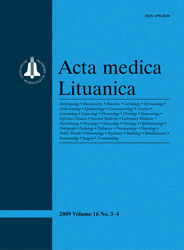 ISSN 1392-0138 ISSN 2029-4174 (online) |
2010 m. Nr. 1-2 The problem of preschool wheeze: new developments, new questions
Preschool wheeze is a common and often difficult to treat symptom. It may rarely be the first presentation of a severe underlying condition. Preschool wheeze is clearly a syndrome, not a single entity, and thus ripe for phenotyping. A number of approaches to phenotyping have been adopted. Epidemiology, based on the temporal patterns of symptoms, has taught us a lot about the medium and long-term implications of early life events, but is not useful for treatment planning. Atopic status is also not useful. Instead, symptom pattern (episodic (viral) and multiple trigger) should be used to decide on treatment. Reduced lung function at birth is associated with a number of maternal factors, including smoking (both by direct and epigenetic mechanisms), atopic status, and pregnancy complications; these children tend to have transient wheeze. Children whose symptoms persist into mid-childhood are born with normal lung function, but have evidence of airflow obstruction at 4–6 years of age. Early atopic sensitization is important in this group. Treatment of pre-school wheeze should be based on relief of present symptoms; there is no known therapy which prevents progression from episodic to multiple trigger symptoms and asthma. Episodic (viral) wheeze is a neutrophilic disease and should be treated with intermittent therapy. Options include inhaled anticholinergics or short-acting β-2 agonists, oral leukotriene receptor antagonists and short-course, high-dose inhaled corticosteroids. Prophylactic inhaled corticosteroids are not useful. Neither prophylactic nor inhaled corticosteroids are effective in preventing progression from an episodic viral to a multiple-trigger pattern. Multipletrigger wheeze may merit a three-step trial (trial period, stop if apparent response, restart only if symptoms return) of prophylactic inhaled corticosteroids or leukotriene receptor antagonists. Recent data have shown that prednisolone should not be a routine treatment for acute exacerbations of episodic (viral) wheeze, but should only be used for really severe excacerbations, defined as being more severe than a routine admission and likely needing high dependency care. This is especially true in the setting of multiple trigger wheeze. Keywords: asthma, inhaled corticosteroid, leukotriene, neutrophil, prednisolone |
Issues:
2011 - Vol.18 No. 1, No. 2, No. 3, No. 4 2010 - Vol.17 No. 1-2, No. 3-4 2009 - Vol.16 No. 1-2, No. 3-4 2008 - Vol.15 No. 1, No. 2, No. 3, No. 4 2007 - Vol.14 No. 1, No. 2, No. 3, No. 4 2006 - Vol.13 No. 1, No. 2, No. 3, No. 4 2005 - Vol.12 No. 1, No. 2, No. 3, No. 4 2004 - Vol.11 No. 1, No. 2, No. 3, No. 4 2003 - Vol.10 No. 1, No. 2, No. 3, No. 4 2002 - Vol.9 No. 1, No. 2, No. 3, No. 4 2001 - Vol.8 No. 1, No. 2, No. 3, No. 4 |